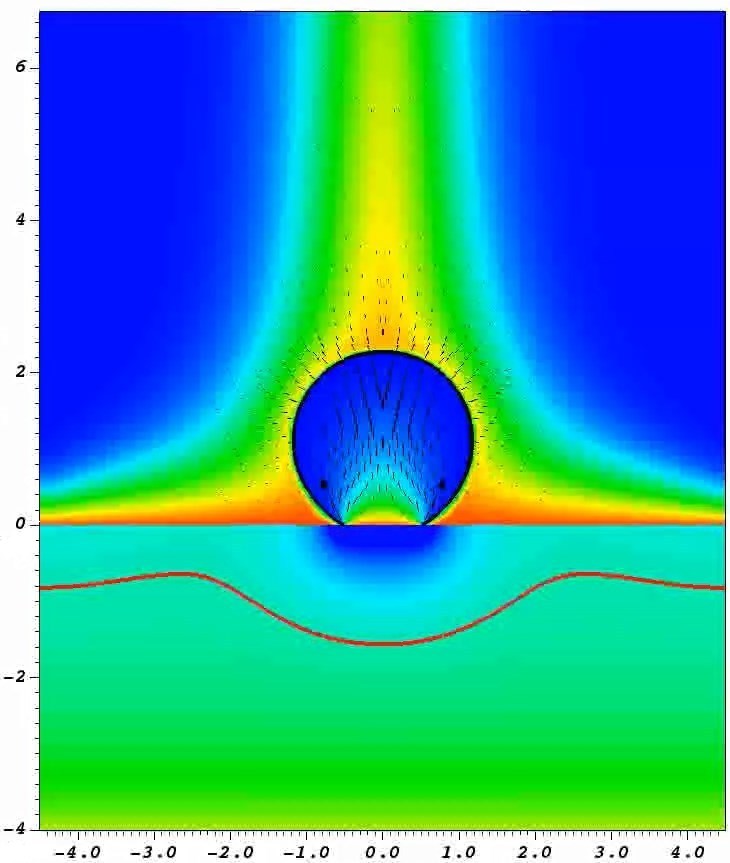Pulsating heat pipe and boiling crisis
We study the physics of self-sustained menisci oscillations[1] in capillaries occurring in the pulsating heat pipe[2] in order to enable its wide industrial use. It is a novel device used for the thermal management of heat emitters like power microelectronics used e.g. in spatial applications[3]. We collaborate with the team of S. Filippeschi team from Pisa University (Italy). The work was done under multiple contracts with CNES, ESA and Airbus DS. It was a subject of several CDD (I. Nekrashevych, M. Abela) and a Ph.D. (X. Zhang, 2019-2022). The physics of boiling has been studied in collaboration with CEA/DES/STMF. The microscale phenomena have been investigated experimentally with B. Cariteau in the PhD of C. Tecchio (2018-2022) (in collaboration with EP/LPICM, P. Roca). The multiscale simulations of boiling using the TrioCFD freeware are under way in collaboration with G. Bois (Figure 5). A study of water flow in the proton-exchange membrane fuel cell have been started in 2022 in collaboration with CEA/DRT/LITEN (B. Mathieu) and CEA/DES/SGLS (E. Saikali et A. Bruneton) within the PhD of M. Rykner.
Figure 1 TrioCFD simulation of bubble growth on a solid wall in boiling (in collaboration with G. Bois, L. Wei). Color shows the temperature difference with the saturation temperature; the vector field corresponds to the fluid velocity. A singularly large velocity at the triple contact line shows the necessity of a multiscale approach.

Fig. 1 TrioCFD simulation of bubble growth on a solid wall in boiling (in collaboration with G. Bois, L. Wei). Color shows the temperature difference with the saturation temperature; the vector field corresponds to the fluid velocity. A singularly large velocity at the triple contact line shows the necessity of a multiscale approach.
Thermoelectricity in complex liquids
We also investigate thermoelectric phenomena in complex liquids; i.e., ionic liquids and ionic nanofluids, and their applications in waste-heat recovery technology. The experimental and theoretical efforts supported by several external funding sources (Horizon2020 FET-Proactive, ANR, and LABEX-PALM) have not only led to uncovering hitherto little known thermoelectric nature of these liquids[4],[5],[6],[7],[8], but also to prototype developments in automotive[9] and renewable energy (heat & electricity cogeneration in hybrid solar heat collectors)[10],[11] sectors.
Quantum friction
The subject of energy dissipation by rotational quantum friction has become a PhD project (2022-2025), currently being explored by Michael Vaz; we also have regular, bimonthly meetings with Prof. S. Buhmann from Kassel Univ., Germany.
Energy networks
Energy networks, expected to be deeply transformed by the ongoing energy transition, are being studied by Emile Emery in a multidisciplinary PhD project (2022-2025) on the French power grid, where statistical physics tools are coupled with the economy of resources (energy & matter), especially the notion of EROI (Energy Return On [Energy] Invested). On a global scale, following the seminal work of several physicist turned economists (Ayres, Kümmel, …), a basic law relating energy efficiency improvements to energy consumption has been extracted from historical series[12].
[1] Zhang, X. & Nikolayev, V. S. Liquid film dynamics with immobile contact line during meniscus oscillation, J. Fluid Mech., 2021 vol. 923, A4; Zhang, X. & Nikolayev, V. S. Dewetting acceleration by evaporation, J. Fluid Mech., 2022 vol. 948, A49.
[2] Nikolayev, V. S. Physical principles and state-of-the-art of modeling of the pulsating heat pipe: A review, Appl. Therm. Eng., 2021 vol. 195, 117111.
[3] Nekrashevych, I. & Nikolayev, V. S. Pulsating Heat Pipe Simulations: Impact of PHP Orientation, Microgravity Sci. Technol., 2019 vol. 31(3), 241 – 248 ;
[4] T. J. Salez, et al., “Thermoelectricity and Thermodiffusion in Magnetic Nanofluids: Entropic Analysis,” Entropy 20, 405 [2018]
[5] T. Salez, et al., “Magnetic enhancement of Seebeck coefficient in ferrofluids,” Nanoscale Advances, 1, 2979 [2019].
[6] K. Bhattacharya, et al.,“STRUCTURAL, THERMODIFFUSIVE AND THERMOELECTRIC PROPERTIES OF MAGHEMITE NANOPARTICLES DISPERSED IN ETHYLAMMONIUM NITRATE,” Chem Engineering, 4(1) 5 [2020].
[7] I. Chikina, et al., “On the ac Measurements of the Electrical Conductivity of Dilute Colloidal Electrolytes,” Colloids Interfaces 7 58 [2023]; I. Chikina, et al., “Charged Colloids at the Metal–Electrolyte Interface,” Colloids Interfaces, 6, 25 [2022]
[8] T. Fiuza, et al., “Ion specific tuning of nanoparticle dispersion in an ionic liquid: a structural, thermoelectric and thermo-diffusive investigation,” Phys. Chem. Chem. Phys., 25 28911 [2023]
[9] A. Tiozzo, et al., “From academia to industry: criteria for upscaling ionic liquid-based thermo-electrochemical cells for large-scale applications,” Energies, 17, 1 [2024].
[10] E. Sani, et al.,“Multifunctional Magnetic Nanocolloids for Hybrid Solar-Thermoelectric Energy Harvesting,” Nanomaterials, 11(4), 1031[2021]
[11] Patent under preparation.
[12] H. Bercegol & H. Benisty, Ecological Economics, 192, 107253 (2022)

Saco NAKAMAE
SPHYNX head,
CEA researcher

Hervé BERCEGOL
CEA researcher

Vadim NIKOLAYEV
CEA researcher



